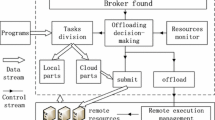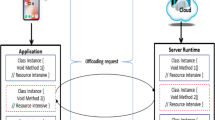Abstract
The increase in capabilities of mobile devices to perform computation tasks has led to increase in energy consumption. While offloading the computation tasks helps in reducing the energy consumption, service availability is a cause of major concern. Thus, the main objective of this work is to reduce the energy consumption of mobile device, while maximising the service availability for users. The multi-criteria decision making (MCDM) TOPSIS method prioritises among the service providing resources such as Cloud, Cloudlet and peer mobile devices. The superior one is chosen for offloading. While availing service from a resource, the proposed fuzzy vertical handoff algorithm triggers handoff from a resource to another, when the energy consumption of the device increases or the connection time with the resource decreases. In addition, parallel execution of tasks is performed to conserve energy of the mobile device. The results of experimental setup with opennebula Cloud platform, Cloudlets and Android mobile devices on various network environments, suggest that handoff from one resource to another is by far more beneficial in terms of energy consumption and service availability for mobile users.


















Similar content being viewed by others
References
Dinh, H. T., Lee, C., Niyato, D., & Wang, P. (2011). A survey of mobile cloud computing: Architecture, applications, and approaches. Wireless Communications and Mobile Computing, 13(18), 1587–1611. doi:10.1002/wcm.1203.
Schulman, A., Navda, V., Ramjee, R., Spring, N., Deshpande, P., Grunewald, C., & Padmanabhan, V. N. (2010). Bartender: A practical approach to energy-aware cellular data scheduling. In Proceedings Of 16th ACM international conference on mobile computing and networking (pp. 85–96). doi:10.1145/1859995.1860006.
Balasubramanian, N., Balasubramanian, A., & Venkataramani, A. (2009). Energy consumption in mobile phones: A measurement study and implications for network applications. In Proceedings of the 9th ACM SIGCOMM conference on internet measurement (pp. 280–293). doi:10.1145/1644893.1644927.
Satyanarayanan, M., Bahl, P., Caceres, R., & Davies, N. (2009). The case for VM-based cloudlets in mobile computing. IEEE Pervasive Computing, 8(4), 14–23. doi:10.1109/MPRV.2009.82.
Canepa, G. H., & Lee, D. (2010). A virtual cloud computing provider for mobile devices. In Proceedings of the 1st ACM workshop on mobile cloud computing and services: Social networks and beyond(MCS), article no. 6 (pp. 1–5). doi:10.1145/1810931.1810937.
Liaskovitis, P., & Schurgers, C. (2010). Energy consumption of multi-hop wireless networks under throughput constraints and range scaling. ACM SIGMOBILE Mobile Computing and Communications Review, 13(3), 1–13. doi:10.1145/1710130.1710132.
Rappaport, T. S. (2002). Wireless communications singapore. Upper Saddle River: Pearson Publications.
Miettinen, P., & Nurminen, J. K. (2010). Energy efficiency of mobile clients in cloud computing. In Proceedings of the 2nd USENIX conference on hot topics in cloud computing, 4–4.
Huang, J., Qian, F., Gerber, A., Mao, Z. M., Sen, S., & Spatcheck O. (2012). A close examination of performance and power characterists of 4G LTE networks. In Proceedings of the 10th international conference on mobile systems, applications, and services (pp. 225–238). doi:10.1145/2307636.2307658.
Lee, J., Su, Y., & Shen, C. (2007). A comparitive study of wireless protocols: Bluetooth, UWB, ZigBee and Wi-Fi. In 33rd annual conference of the IEEE, IECON, 2007 (pp. 46–51). doi:10.1109/IECON.2007.4460126.
Baker, N. (2005). ZigBee and Bluetooth strengths and weaknesses for industrial applications. IEEE Computing and Control Engineering Journal, 16(2), 20–25. doi:10.1049/cce:20050204.
Bluetooth Specification Version 4.0 [Vol 0]. (30 June 2010). https://www.bluetooth.org/en-us/specification/adopted-specifications.
Friedman, R., Kogan, A., & Krivolapov, Y. (2011). On power and throughput tradeoffs of WiFi and bluetooth in smartphones. IEEE Transactions on Mobile Computing, 12(7), 1363–1376. doi:10.1109/TMC.2012.117.
Siekkinen, M., Hiienkari, M., & Nurminen, J. K. (2012). How low energy is bluetooth low energy? Comparitive measurements with ZigBee/802.15.4. In Wireless communications and networking conference workshops (WCNCW) (pp. 232–237). doi:10.1109/WCNCW.2012.6215496.
User Equipment (UE) conformance specification; Radio transmission and reception (FDD); Part 1: Conformance specification 3GPP TS 34.121-1, V 11.4.0. (26 June 2014). http://www.3gpp.org/DynaReport/34121-1.htm.
Evolved Universal Terrestrial Radio Access (E-UTRA); User Equipment (UE) radio transmission and reception, 3GPP TS 36.101, V 9.10.0 (6 January 2012). http://www.3gpp.org/dynareport/36101.htm.
Cuervo, E., Balasubramanian, A., Cho, D., Wolman, A., Saroiu, S., Chandra, R., & Bahl, P. (2010). MAUI: Making smartphones last longer with code offload. In Proceedings of the ACM 8th international conference on mobile systems, applications, and services (pp. 49–62). doi:10.1145/1814433.1814441.
Gordon, M. S., Jamshidi, D. A., Mahlke, S.A., Mao, Z. M., & Chen X. (2012). COMET: Code offload by migrating execution transparently. In Proceedings of the 10th USENIX conference on operating systems design and implementation (pp. 93–106).
Gu, X., Nahrstedt, K., Messer, A., Greenberg, I., & Milojicic, D. (2004). Adaptive offloading for pervasive computing. IEEE Pervasive Computing, 3(3), 66–73. doi:10.1109/MPRV.2004.1321031.
Marinelli, E. E. (2009). Hyrax: Cloud computing on mobile sevices using MapReduce. MS thesis at School of Computer Science. Carnegie Mellon University. http://reports-archive.adm.cs.cmu.edu/anon/2009/CMU-CS-09-164
Dou, A., Kalogeraki, V., Gunopulos, D., Mielikainen, T., & Tuulos, V. H. (2010). Misco: A MapReduce framework for mobile systems. In Proceedings of the ACM 3rd international conference on pervasive technologies related to assistive environments (PETRA’10), article no. 32 (pp. 1–8). doi:10.1145/1839294.1839332.
Wolski, R., Gurun, S., Krintz, C., & Nurmi, D. (2008). Using bandwidth data to make computation offloading decisions. In Proceedings of the IEEE international symposium on parallel and distributed processing (pp. 1–8). doi:10.1109/IPDPS.2008.4536215.
Lin, Y., Lin, A., Hsu, C., & King, C. (2013). Context-aware decision engine for mobile cloud offloading. In Proceedings of the IEEE wireless communications and networking conference workshops (WCNCW) (pp. 111–116). doi:10.1109/WCNCW.2013.6533324.
Silva, J. N., Veiga, L., & Ferreira, P. (2008). SPADE—scheduler for parallel and distributed execution from mobile devices. In Proceedings of the ACM 6th international workshop on middleware for pervasive and ad-hoc computing (pp. 25–30). doi:10.1145/1462789.1462794.
March, V., Gu, Y., Leonardi, E., Goh, G., Kirchberg, M. B., & Lee, S. (2011). \(\mu \) Cloud: Towards a new paradigm of rich mobile applications. In Proceedings of the 8th international conference on mobile web information systems (MobiWIS 2011), procedia computer science (pp. 618–624). doi: http://dx.doi.org/10.1016/j.procs.2011.07.080.
Yang, K., Ou, S., & Chen, H. (2008). On effective offloading services for resource-constrained mobile devices running heavier mobile Internet applications. IEEE Communications Magazine, 46(1), 56–63. doi:10.1109/MCOM.2008.4427231.
Chen, I., Gu, B., George, S. E., & Cheng, S. (2005). On failure recoverability of client-server applications in mobile wireless environments. IEEE Transactions On Reliability, 45(1), 115–122. doi:10.1109/TR.2004.837518.
Lin, Y., Chu, E. T. H., Lai, Y., & Huang, T. (2013). Time-and-energy-aware computation offloading in handheld devices to coprocessors and clouds. IEEE Systems Journal. doi:10.1109/JSYST.2013.2289556.
Lee, K., & Shin. I. (2013). User mobility-aware decision making for mobile computation offloading. In Proceedings of the IEEE 1st international conference on cyber-physical systems, networks, and applications (CPSNA) (pp. 116–119). doi:10.1109/CPSNA.2013.6614257.
Rahimi, M. R., Venkatasubramanian, N., & Vasilakos, A. V. (2013). MuSIC: Mobility-aware optimal service allocation in mobile cloud computing. In Proceedings of the IEEE 6th international conference on cloud computing (pp. 75–82). doi:10.1109/CLOUD.2013.100.
Ravi, A., & Peddoju, S. K. (2014). Mobility managed energy efficient Android mobile devices using cloudlet. In Proceedings of the IEEE students’ technology symposium (TechSym), 2014 (pp. 402–407). doi:10.1109/TechSym.6808085.
Ravi, A., & Peddoju, S. K. (2013). Energy efficient seamless service provisioning in mobile cloud computing. In Proceedings of the IEEE 7th international symposium on service oriented system engineering (SOSE) (pp. 463–471). doi:10.1109/SOSE.2013.67.
Dikaiakos, M. D., Katsaros, D., Mehra, P., Pallis, G., & Vakali, A. (2009). Cloud computing: Distributed internet computing for IT and scientific research. IEEE Internet Computing, 13(5), 10–13. doi:10.1109/MIC.2009.103.
Federal Communication Commissions . http://www.fcc.gov/.
Power consumption of WiFi, 3G and Bluetooth. http://www.arrl.org/files/file/Regulatory/Part%2097%20-%2004-28-2011.
Opricovic, S., & Tzeng, G. (2004). Compromise solution by MCDM methods: A comparative analysis of VIKOR and TOPSIS. European Journal of Operational Research, 156(2), 445–455. doi:10.1016/S0377-2217(03)00020-1.
Mendel, J. M. (1995). Fuzzy logic systems for engineering: A tutorial. Proceedings of the IEEE, 83(3), 345–377. doi:10.1109/5.364485.
PowerTutor for profiling energy consumption. http://ziyang.eecs.umich.edu/projects/powertutor/.
Java Reflection API. http://docs.oracle.com/javase/tutorial/reflect/.
LibLeptonica Open source software for image to text conversion in ubuntu. http://www.leptonica.org/vs2008doc/overview.html.
Andrews, J. G., Buzzi, S., Choi, W., Handly, S. V., Lozano, A., et al. (2014). What will 5G BE? IEEE Journal on Selected Areas in Communications, 32(6), 1065–1082. doi:10.1109/JSAC.2014.2328098.
Badoi, C., Prasad, N., Croitoru, V., & Prasad, R. (2011). 5G based on cognitive radio. Wireless Personal Communications, 57(3), 441–464. doi:10.1007/s11277-010-0082-9.
Prasad, R. (2012). Future networks and technologies supporting innovative communications. http://vbn.aau.dk/ws/files/75175138/Future_Networks_and_Technologies_supporting_Innovative_Communications.
Golaup, A., Mustapha, M., & Patanapongpibul, L. B. (2009). Femtocell access control strategy in UMTS and LTE. IEEE Communications Magazine, 47(9), 117–123. doi:10.1109/MCOM.2009.5277464.
Hossain, E., Rasti, M., Tabassum, H., & Abdelnasser, A. (2014). Evolution toward 5G multi-tier cellular wireless networks: An interference management perspective. IEEE Wireless Communications, 21(3), 118–127. doi:10.1109/MWC.2014.6845056.
Author information
Authors and Affiliations
Corresponding author
Appendix
Appendix
This section describes how the weights for various parameters have been chosen in the MCDM TOPSIS method. We perform a pairwise comparison of the four parameters, energy consumption for processing (EP), energy consumption for communication (EC), Waiting Time (WT) and connection time (CT). The pairwise comparison values vary for various battery levels as mentioned in section in the MCDM methodology. Here, we describe the value selection for the battery level ranging from 5 to 40.

Solving the fractions, we get:

Following the eigen matrix multiplication, we get:
M = \(\left\{ 46.6 \quad 28.4 \quad 10.1 \quad 10.1\right\} \)
Adding the above obtained column values we get, M = 95.2.
Now, we divide the column value with the sum of the column values to obtain:
M = \(\left\{ 0.48 \quad 0.29 \quad 0.106 \quad 0.106\right\} \)
The value of M is normalized to obtain the values in Table 2. Such pairwise comparison is performed for different battery level left in the mobile device and the values obtained as discussed.
Rights and permissions
About this article
Cite this article
Ravi, A., Peddoju, S.K. Handoff Strategy for Improving Energy Efficiency and Cloud Service Availability for Mobile Devices. Wireless Pers Commun 81, 101–132 (2015). https://doi.org/10.1007/s11277-014-2119-y
Published:
Issue Date:
DOI: https://doi.org/10.1007/s11277-014-2119-y




